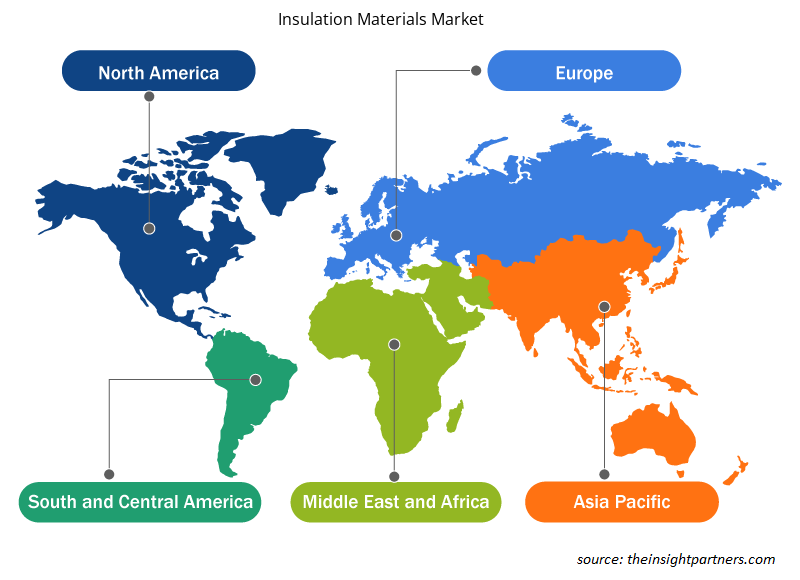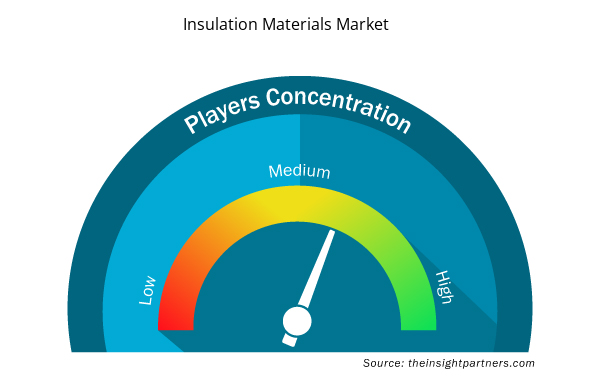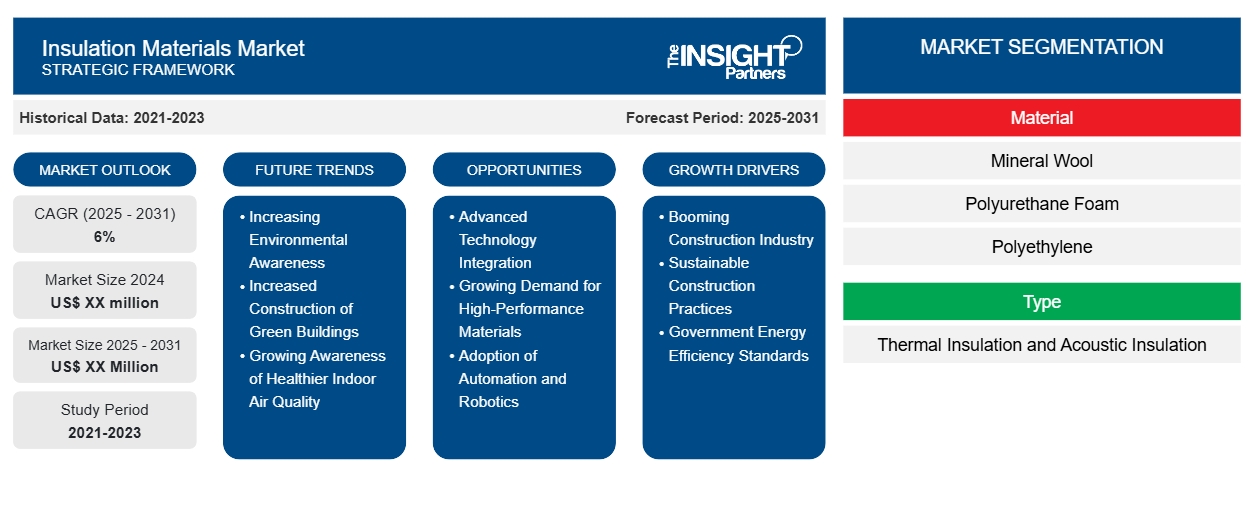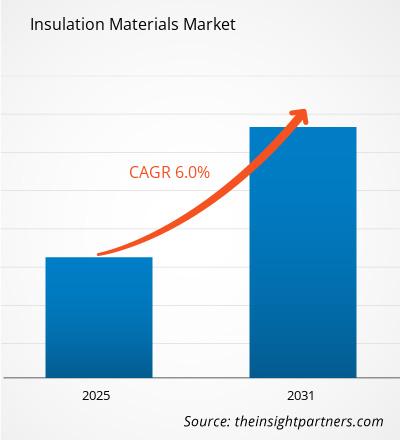Le marché des matériaux d'isolation devrait enregistrer un TCAC de 6 % de 2023 à 2031, avec une taille de marché passant de XX millions USD en 2023 à XX millions USD d'ici 2031.
Le rapport présente une analyse basée sur le matériau (laine minérale, mousse de polyuréthane, polyéthylène, fibre de verre, polystyrène et autres). Le rapport est segmenté par type (isolation thermique et isolation acoustique). Le rapport est segmenté par application (automobile, aérospatiale, marine, électricité et électronique, bâtiment et construction, pétrole et gaz, et autres). L'analyse mondiale est ensuite décomposée au niveau régional et par principaux pays. La taille du marché et les prévisions aux niveaux mondial, régional et national pour tous les segments de marché clés sont couvertes dans le cadre du périmètre. Le rapport offre la valeur en USD pour l'analyse et les segments ci-dessus. Le rapport fournit des statistiques clés sur l'état du marché des principaux acteurs du marché et offre des tendances et des opportunités de marché.
Objectif du rapport
Le rapport sur le marché des matériaux d'isolation de The Insight Partners vise à décrire le paysage actuel et la croissance future, les principaux facteurs moteurs, les défis et les opportunités. Cela fournira des informations à diverses parties prenantes commerciales, telles que :
- Fournisseurs/fabricants de technologie : pour comprendre l’évolution de la dynamique du marché et connaître les opportunités de croissance potentielles, leur permettant de prendre des décisions stratégiques éclairées.
- Investisseurs : Effectuer une analyse complète des tendances concernant le taux de croissance du marché, les projections financières du marché et les opportunités qui existent tout au long de la chaîne de valeur.
- Organismes de réglementation : Réglementer les politiques et surveiller les activités du marché dans le but de minimiser les abus, de préserver la confiance des investisseurs et de maintenir l’intégrité et la stabilité du marché.
Segmentation du marché des matériaux isolants
Matériel
- Laine minérale
- Mousse de polyuréthane
- Polyéthylène
- Fibre de verre
- Polystyrène
Taper
- Isolation thermique et acoustique
Application
- Automobile
- Aérospatial
- Marin
- Électricité et électronique
- Bâtiment et construction
- Pétrole et gaz
Géographie
- Amérique du Nord
- Europe
- Asie-Pacifique
- Amérique du Sud et Amérique centrale
- Moyen-Orient et Afrique
Géographie
- Amérique du Nord
- Europe
- Asie-Pacifique
- Amérique du Sud et Amérique centrale
- Moyen-Orient et Afrique
Personnalisez ce rapport en fonction de vos besoins
Vous bénéficierez d'une personnalisation gratuite de n'importe quel rapport, y compris de certaines parties de ce rapport, d'une analyse au niveau des pays, d'un pack de données Excel, ainsi que de superbes offres et réductions pour les start-ups et les universités.
- Obtenez les principales tendances clés du marché de ce rapport.Cet échantillon GRATUIT comprendra une analyse de données, allant des tendances du marché aux estimations et prévisions.
Facteurs de croissance du marché des matériaux isolants
- Le secteur de la construction est en plein essor : Le marché des matériaux d'isolation est porté par le secteur de la construction en plein essor. L'urbanisation et la croissance démographique croissante créent une demande accrue de nouveaux bâtiments résidentiels et commerciaux. Les activités de construction plus importantes nécessitent des solutions d'isolation de meilleure qualité pour garantir une efficacité énergétique accrue et répondre aux normes de construction actuelles.
- Pratiques de construction durables : La prise de conscience de la construction durable augmente également la demande d'isolation. L'efficacité énergétique des structures est la principale préoccupation de tous les constructeurs du monde de nos jours, avec une consommation d'énergie moindre et des émissions de gaz à effet de serre plus faibles. L'isolation s'inscrit dans ces objectifs, et l'investissement porte sur des matériaux isolants de qualité supérieure qui tiennent compte de la durabilité et améliorent les performances globales du bâtiment.
- Normes gouvernementales d'efficacité énergétique : En outre, les gouvernements qui imposent des normes d'efficacité énergétique dans les bâtiments stimulent la croissance. La plupart des pays du monde ont mis en place des codes de construction stricts et renforcé les normes d'isolation des bâtiments. Des normes d'isolation plus strictes nécessitent que les entreprises de construction utilisent de meilleurs matériaux d'isolation ; par conséquent, la demande d'isolation sur le marché augmente.
Tendances futures du marché des matériaux isolants
- Sensibilisation croissante à l'environnement : La sensibilisation croissante à l'environnement fait des matériaux isolants biosourcés un pionnier dans la préoccupation du marché de l'isolation. Les consommateurs et les constructeurs se concentrent sur la durabilité, car les consommateurs optent pour des options biosourcées, qui incluent la cellulose, le chanvre et la laine, pour obtenir des performances thermiques efficaces avec un apport relativement faible de combustible fossile, ce qui rend cette option attrayante pour la préoccupation environnementale des parties prenantes.
- Construction accrue de bâtiments écologiques : De plus, les politiques gouvernementales qui rendent les bâtiments écologiques stimulent la demande d'isolants biosourcés. Des mesures incitatives et des réglementations ont été mises en place par plusieurs pays pour encourager l'utilisation de matériaux « verts » dans la construction. Ce soutien politique alimente la croissance du marché et incite les producteurs à innover dans le développement de technologies d'isolation biosourcée. Par conséquent, ils étendent leurs applications à divers projets.
- Sensibilisation croissante à une meilleure qualité de l’air intérieur : Outre les avantages environnementaux, de nombreux matériaux isolants à base biologique offrent également une meilleure qualité de l’air intérieur. La plupart de ces produits ne contiennent aucun produit chimique nocif, ce qui rend les environnements de vie et de travail beaucoup plus sains. À mesure que les préoccupations concernant la qualité de l’air intérieur augmentent, les constructeurs et les propriétaires sont plus susceptibles de se tourner vers des options à base biologique, ce qui stimulera la demande.
Opportunités de marché pour les matériaux isolants
- Intégration de technologies avancées : L’intégration de technologies avancées devrait ouvrir des perspectives de croissance importantes sur le marché des matériaux isolants. Les systèmes d’isolation intelligents qui utilisent des capteurs et la technologie de l’Internet des objets permettent de surveiller et d’optimiser l’efficacité énergétique en temps réel. Les données ainsi fournies par ces systèmes d’isolation intelligents peuvent profiter aux utilisateurs dans la mesure où ils peuvent prendre des décisions éclairées concernant l’énergie utilisée et l’efficacité de leur isolation.
- Demande croissante de matériaux hautes performances : En dehors de cela, des matériaux hautes performances tels que les panneaux isolants sous vide et les aérogels sont en cours de développement et augmentent rapidement les capacités d'isolation. Ces matériaux avancés offrent une résistance thermique supérieure dans des profils plus fins, ce qui séduit les architectes et les constructeurs qui cherchent à maximiser l'espace avec de faibles coûts énergétiques. Cette focalisation sur les performances alimente la demande de solutions d'isolation de pointe.
- Adoption de l'automatisation et de la robotique : De plus, l'efficacité de la production et les coûts sont préservés grâce à l'automatisation et à la robotisation des processus de fabrication. En conséquence, les entreprises seront en mesure de garantir des prix compétitifs avec des matériaux d'isolation de qualité. Cette augmentation de la productivité ouvrira la voie à un accès plus large aux marchés de nouvelles régions.
Aperçu régional du marché des matériaux d'isolation
Les tendances et facteurs régionaux influençant le marché des matériaux isolants tout au long de la période de prévision ont été expliqués en détail par les analystes d’Insight Partners. Cette section traite également des segments et de la géographie du marché des matériaux isolants en Amérique du Nord, en Europe, en Asie-Pacifique, au Moyen-Orient et en Afrique, ainsi qu’en Amérique du Sud et en Amérique centrale.

- Obtenez les données régionales spécifiques au marché des matériaux d'isolation
Portée du rapport sur le marché des matériaux d'isolation
| Attribut de rapport | Détails |
|---|---|
| Taille du marché en 2023 | XX millions de dollars américains |
| Taille du marché d'ici 2031 | XX millions de dollars américains |
| Taux de croissance annuel composé mondial (2023-2031) | 6% |
| Données historiques | 2021-2022 |
| Période de prévision | 2024-2031 |
| Segments couverts | Par matériau
|
| Régions et pays couverts | Amérique du Nord
|
| Leaders du marché et profils d'entreprises clés |
|
Densité des acteurs du marché des matériaux isolants : comprendre son impact sur la dynamique commerciale
Le marché des matériaux d'isolation connaît une croissance rapide, tirée par la demande croissante des utilisateurs finaux en raison de facteurs tels que l'évolution des préférences des consommateurs, les avancées technologiques et une plus grande sensibilisation aux avantages du produit. À mesure que la demande augmente, les entreprises élargissent leurs offres, innovent pour répondre aux besoins des consommateurs et capitalisent sur les tendances émergentes, ce qui alimente davantage la croissance du marché.
La densité des acteurs du marché fait référence à la répartition des entreprises ou des sociétés opérant sur un marché ou un secteur particulier. Elle indique le nombre de concurrents (acteurs du marché) présents sur un marché donné par rapport à sa taille ou à sa valeur marchande totale.
Les principales entreprises opérant sur le marché des matériaux d'isolation sont :
- Société de couverture Atlas
- BASF SE
- Bayer AG
- Société Bridgestone
- Evonik Industries AG
Avis de non-responsabilité : les sociétés répertoriées ci-dessus ne sont pas classées dans un ordre particulier.

- Obtenez un aperçu des principaux acteurs du marché des matériaux d'isolation
Principaux arguments de vente
- Couverture complète : Le rapport couvre de manière exhaustive l’analyse des produits, des services, des types et des utilisateurs finaux du marché des matériaux d’isolation, offrant un paysage holistique.
- Analyse d’experts : Le rapport est compilé sur la base d’une compréhension approfondie des experts et analystes du secteur.
- Informations à jour : Le rapport garantit la pertinence commerciale en raison de sa couverture des informations récentes et des tendances des données.
- Options de personnalisation : ce rapport peut être personnalisé pour répondre aux exigences spécifiques du client et s'adapter parfaitement aux stratégies commerciales.
Le rapport de recherche sur le marché des matériaux d’isolation peut donc aider à ouvrir la voie au décodage et à la compréhension du scénario de l’industrie et des perspectives de croissance. Bien qu’il puisse y avoir quelques préoccupations valables, les avantages globaux de ce rapport ont tendance à l’emporter sur les inconvénients.
- Analyse historique (2 ans), année de base, prévision (7 ans) avec TCAC
- Analyse PEST et SWO
- Taille du marché Valeur / Volume - Mondial, Régional, Pays
- Industrie et paysage concurrentiel
- Ensemble de données Excel



Report Coverage
Revenue forecast, Company Analysis, Industry landscape, Growth factors, and Trends

Segment Covered
This text is related
to segments covered.

Regional Scope
North America, Europe, Asia Pacific, Middle East & Africa, South & Central America

Country Scope
This text is related
to country scope.
Questions fréquemment posées
The growing demand for bio-based insulation materials is expected to be the key market trends.
Based on geography, Asia Pacific held the largest share of the insulation materials market due to rapid urbanization and industrialization in countries such as China and India have significantly increased construction activities. This surge in new residential and commercial buildings drives demand for insulation materials to improve energy efficiency and meet building codes.
Based on material, the polyurethane foam segment is expected to witness the fastest growth during the forecast period
The growing construction industry is driving the market growth.
Atlas Roofing Corporation; BASF SE; Covestro AG; Bridgestone Corporation; Evonik Industries; GAF; Huntsman International LLC.; Kingspan Group; ROCKWOOL International A/S; and Dow are some of the key players operating in the insulation materials market
The Insulation Materials Market is estimated to witness a CAGR of 6% from 2023 to 2031
Trends and growth analysis reports related to Chemicals and Materials : READ MORE..
The List of Companies
- Atlas Roofing Corporation
- BASF SE
- Bayer AG
- Bridgestone Corporation
- Evonik Industries AG
- GAF
- Huntsman International LLC
- Kingspan Group
- ROCKWOOL International A/S
- The Dow Chemical Company
The Insight Partners performs research in 4 major stages: Data Collection & Secondary Research, Primary Research, Data Analysis and Data Triangulation & Final Review.
- Data Collection and Secondary Research:
As a market research and consulting firm operating from a decade, we have published and advised several client across the globe. First step for any study will start with an assessment of currently available data and insights from existing reports. Further, historical and current market information is collected from Investor Presentations, Annual Reports, SEC Filings, etc., and other information related to company’s performance and market positioning are gathered from Paid Databases (Factiva, Hoovers, and Reuters) and various other publications available in public domain.
Several associations trade associates, technical forums, institutes, societies and organization are accessed to gain technical as well as market related insights through their publications such as research papers, blogs and press releases related to the studies are referred to get cues about the market. Further, white papers, journals, magazines, and other news articles published in last 3 years are scrutinized and analyzed to understand the current market trends.
- Primary Research:
The primarily interview analysis comprise of data obtained from industry participants interview and answers to survey questions gathered by in-house primary team.
For primary research, interviews are conducted with industry experts/CEOs/Marketing Managers/VPs/Subject Matter Experts from both demand and supply side to get a 360-degree view of the market. The primary team conducts several interviews based on the complexity of the markets to understand the various market trends and dynamics which makes research more credible and precise.
A typical research interview fulfils the following functions:
- Provides first-hand information on the market size, market trends, growth trends, competitive landscape, and outlook
- Validates and strengthens in-house secondary research findings
- Develops the analysis team’s expertise and market understanding
Primary research involves email interactions and telephone interviews for each market, category, segment, and sub-segment across geographies. The participants who typically take part in such a process include, but are not limited to:
- Industry participants: VPs, business development managers, market intelligence managers and national sales managers
- Outside experts: Valuation experts, research analysts and key opinion leaders specializing in the electronics and semiconductor industry.
Below is the breakup of our primary respondents by company, designation, and region:

Once we receive the confirmation from primary research sources or primary respondents, we finalize the base year market estimation and forecast the data as per the macroeconomic and microeconomic factors assessed during data collection.
- Data Analysis:
Once data is validated through both secondary as well as primary respondents, we finalize the market estimations by hypothesis formulation and factor analysis at regional and country level.
- Macro-Economic Factor Analysis:
We analyse macroeconomic indicators such the gross domestic product (GDP), increase in the demand for goods and services across industries, technological advancement, regional economic growth, governmental policies, the influence of COVID-19, PEST analysis, and other aspects. This analysis aids in setting benchmarks for various nations/regions and approximating market splits. Additionally, the general trend of the aforementioned components aid in determining the market's development possibilities.
- Country Level Data:
Various factors that are especially aligned to the country are taken into account to determine the market size for a certain area and country, including the presence of vendors, such as headquarters and offices, the country's GDP, demand patterns, and industry growth. To comprehend the market dynamics for the nation, a number of growth variables, inhibitors, application areas, and current market trends are researched. The aforementioned elements aid in determining the country's overall market's growth potential.
- Company Profile:
The “Table of Contents” is formulated by listing and analyzing more than 25 - 30 companies operating in the market ecosystem across geographies. However, we profile only 10 companies as a standard practice in our syndicate reports. These 10 companies comprise leading, emerging, and regional players. Nonetheless, our analysis is not restricted to the 10 listed companies, we also analyze other companies present in the market to develop a holistic view and understand the prevailing trends. The “Company Profiles” section in the report covers key facts, business description, products & services, financial information, SWOT analysis, and key developments. The financial information presented is extracted from the annual reports and official documents of the publicly listed companies. Upon collecting the information for the sections of respective companies, we verify them via various primary sources and then compile the data in respective company profiles. The company level information helps us in deriving the base number as well as in forecasting the market size.
- Developing Base Number:
Aggregation of sales statistics (2020-2022) and macro-economic factor, and other secondary and primary research insights are utilized to arrive at base number and related market shares for 2022. The data gaps are identified in this step and relevant market data is analyzed, collected from paid primary interviews or databases. On finalizing the base year market size, forecasts are developed on the basis of macro-economic, industry and market growth factors and company level analysis.
- Data Triangulation and Final Review:
The market findings and base year market size calculations are validated from supply as well as demand side. Demand side validations are based on macro-economic factor analysis and benchmarks for respective regions and countries. In case of supply side validations, revenues of major companies are estimated (in case not available) based on industry benchmark, approximate number of employees, product portfolio, and primary interviews revenues are gathered. Further revenue from target product/service segment is assessed to avoid overshooting of market statistics. In case of heavy deviations between supply and demand side values, all thes steps are repeated to achieve synchronization.
We follow an iterative model, wherein we share our research findings with Subject Matter Experts (SME’s) and Key Opinion Leaders (KOLs) until consensus view of the market is not formulated – this model negates any drastic deviation in the opinions of experts. Only validated and universally acceptable research findings are quoted in our reports.
We have important check points that we use to validate our research findings – which we call – data triangulation, where we validate the information, we generate from secondary sources with primary interviews and then we re-validate with our internal data bases and Subject matter experts. This comprehensive model enables us to deliver high quality, reliable data in shortest possible time.


 Obtenez un échantillon gratuit pour ce rapport
Obtenez un échantillon gratuit pour ce rapport